|
|
|
Manifest Technology Blog
-- Site:
| Articles
| Galleries
| Resources
| DVI Tech
| About
| Site Map
|
DVI Technology:
| Chronology
| Products
| Applications
| Galactic Challenge
| Publications
| Photos & Videos
|
DVI Technology: 1982-1992
by Douglas Dixon
DVI (Digital Video Interactive) Technology:
Interactive video applications on
the PC, in 1989 --
with real-time interactive
full-screen full-motion video and audio.
Developed at the David Sarnoff Research Center (RCA Labs) starting in 1982
and brought to market by Intel Corp. though 1992.
2009 was the 20th anniversary of the first commercial DVI product, the Intel Pro750 ADP,
which shipped in July 1989. This was the first PC product that provided real-time,
interactive, full-screen, 30 fps motion video playback --
streaming from a CD-ROM, and running on the 386-based PC/AT platform -- almost a decade before the introduction
of DVD. See Intel DVI Pro750
Product Family (1989)
 DVI Technology Overview
DVI Technology Overview
See also -- DVI Group on LinkedIn - www.linkedin.com/groups?gid=1780861
See also -- DVI on Wikipedia - http://en.wikipedia.org/wiki/Digital_Video_Interactive
Updates
- 4/15/09 - Updated publications list
- 1/25/09 - Photos and videos, additional publications
Digital Video Interactive (DVI) Technology brought interactive motion video
applications to the PC platform. The futuristic concept of PC applications with integrated
compressed motion video playing from CD-ROM was developed at the David Sarnoff Research
Center beginning in 1983. DVI was then brought to market by Intel Corp. beginning in 1989,
as a series of chip and board products with software development libraries for DOS,
Windows, and OS/2. This technology lives on in Intel's Indeo video compression algorithms
and Intel Smart Video Recorder video capture boards.
 |
Intel / IBM DVI ActionMedia II product
Named "Best of Show" and "Best Multimedia Product"
at COMDEX/Fall '91 |
 |
Digital Video Interactive named as 1987 SIGGRAPH
technology development
by the ACM SIGGRAPH 98 History Project
in the SIGGRAPH 98 Time Tunnel (25th Conference) |
See Life Before
the Chips: Simulating DVI Technology, D. Dixon, CACM, July 1989
[ Top ]
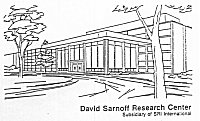

  |
The development of DVI Technology began in 1983 at the David Sarnoff
Research Center (a.k.a. RCA Laboratories), leading to the initial Galactic
Challenge application simulation in March 1984.
Chip design and pilot application development drove through 1985, through the confusion
of the General Electric acquisition of RCA, which was announced in December 1985 and
completed in 1986.
The first chips arrived in December 1986, leading to the first public
announcement at the Second CD-ROM conference in March 1987.
|
  |
G.E. transferred the Sarnoff Labs to SRI International in February
1987,
and then sold the DVI technology to Intel in November 1988. Almost all the original
DVI Technology group also transferred from Sarnoff to Intel at
that time.
Intel moved the Princeton Operation to the Plainsboro building in June 1989.
|
   |
The Pro750 ADP 7-board set shipped in
July
1989 with AVSS DOS software, followed by the ActionMedia 750 boards in
April 1990.
The ActionMedia II boards with the second-generation i750 PB/DB chips shipped in
November 1991, and won "Best of Show" at Comdex/Fall
'91.
The next-generation AVK
software shipped for IBM OS/2 1.3 in November 1990, followed by the
Windows 3.1 and OS/2
2.0 versions in May 1992
|
  |
In Fall 1992 Microsoft announced Video for Windows with
Intel scalable
Indeo Video algorithm (derived from RTV). Intel also announced the RT Video board which
evolved into the continuing Smart Video recorder product line. |
|
On Sept. 17, 1992 Intel announced the closing of the Princeton
Operation,
to be merged into its facilities in Hillsboro, Oregon and Chandler, Arizona. |
[ Top ]
 Early
technical simulations of the DVI product concept developed at Sarnoff in 1983 demonstrated
the feasibility of aggressive motion video compression to PC / CD-ROM data rates Early
technical simulations of the DVI product concept developed at Sarnoff in 1983 demonstrated
the feasibility of aggressive motion video compression to PC / CD-ROM data rates
- Motion video compression with multi-resolution pyramid approach,
becomes PLV
- YIQ color subsampling to 4:1:1 for data reduction

The Galactic Challenge demonstration developed at Sarnoff in 1984
included many seminal ideas which were to become key concepts in DVI technology and future
multimedia applications
- Compressed motion video and audio at PC data rates
- Interactive control of motion through environment
- 360-degree panoramas seamed from still photos
- Animated overlays of objects and motion video
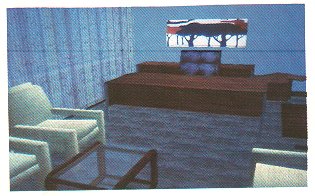
The microcodable video processor architecture developed through 1985-86
provided powerful support for video / graphics operations
- 2-D video effects: fast polygon generation and moving objects
- 3-D rendering: texture-mapped 3-D scene generation with hidden-surface
removal and smooth (Gouraud) shading
- Fisheye panoramas
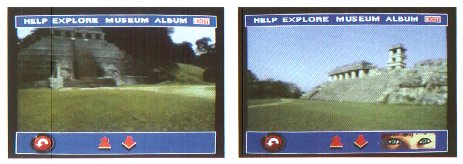
The DVI Pilot applications developed in 1986 demonstrated
the potential of interactive video-graphic applications
- Palenque: Surrogate travel adventure with motion video
travel, 360-degree panoramas, video help, and graphical overlays
- Sesame Street: Children's wordbook with coordinated video and
audio clips, and text effects
- Design & Decorate: 3-D texture-mapped interior design
visualization
- Flight Simulator: Real-time 3-D texture-mapped scenes
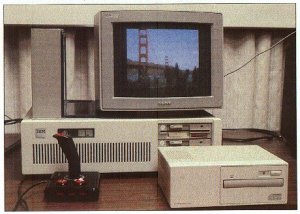
First real-time Video Processor chips, 750 PA/DA, December
1986
Decoded first compressed motion video sequences
First public demonstration of DVI Technology, March 1987
- Pilot applications playing motion video from CD-ROM on 6 MHz IBM PC/AT
- First real-time AVSS DOS development software, multi-tasked
applications and real-time video and audio decompression under DOS
 Introduction of RTV Real-Time Video compression algorithm
in March 1988, which evolves into the Intel Indeo video and audio compressor
product lines Introduction of RTV Real-Time Video compression algorithm
in March 1988, which evolves into the Intel Indeo video and audio compressor
product lines
 First PC product for real-time,
interactive, full-screen, 30 fps motion video and audio playback: Shipped
Pro750 ADP, July 1989 First PC product for real-time,
interactive, full-screen, 30 fps motion video and audio playback: Shipped
Pro750 ADP, July 1989
Shipped ActionMedia 750 board set with AVSS 2.10 DOS software, April 1990
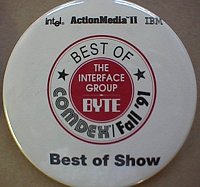
Intel and IBM ship ActionMedia II board set, November 1991
with i750 PB/DB second-generation Video Processor chip set
Wins "Best of Show" and "Best
Multimedia Product" at COMDEX/Fall '91
First Digital Compression Facility (DCF) for PLV compression, 1991
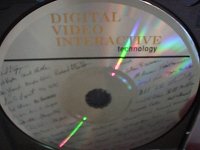 Real-time
video playback and capture under OS/2 and Windows, Nov. 1991, May 1992 Real-time
video playback and capture under OS/2 and Windows, Nov. 1991, May 1992
Portable AVK software (Audio / Video Kernel) for multiple video & audio streams
- Full-screen or genlocked windowed, fully interactive,
full frame rate
- Programmable resolution and frame rates for playback and capture
- Runs on PC / ISA and PS/2 MCI bus, under Windows, OS/2, and DOS
- Displays NTSC and PAL formats on VGA and XGA displays; Captures
NTSC and PAL

Indeo real-time PC software decompression (from RTV) under Video for
Windows, Fall 1992
Becomes Intel
Indeo video and audio scalable compression product line
RT Video board product (becomes Smart Video Recorder) for real-time
capture
Becomes Intel
Smart Video Recorder product line
[ Top ]
|
